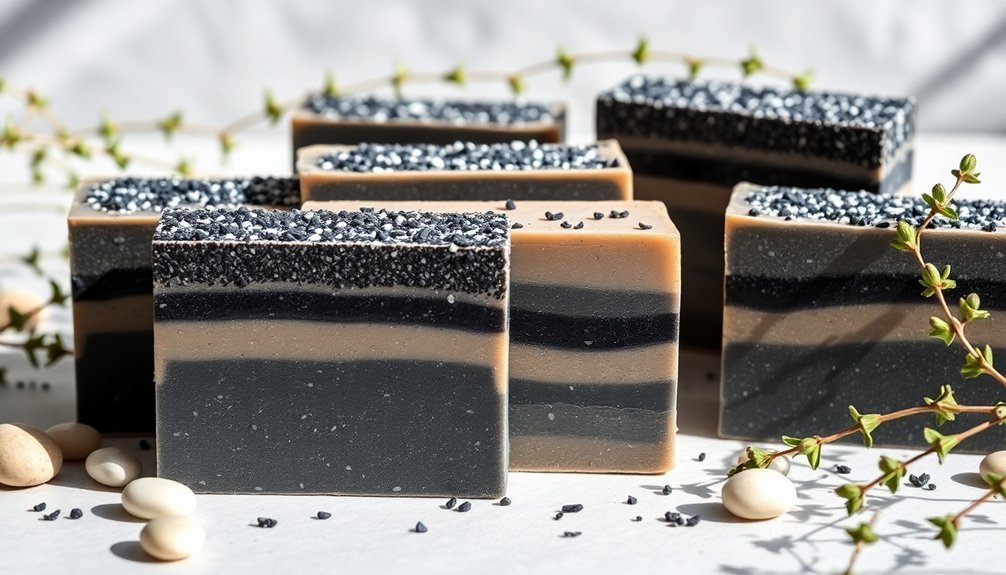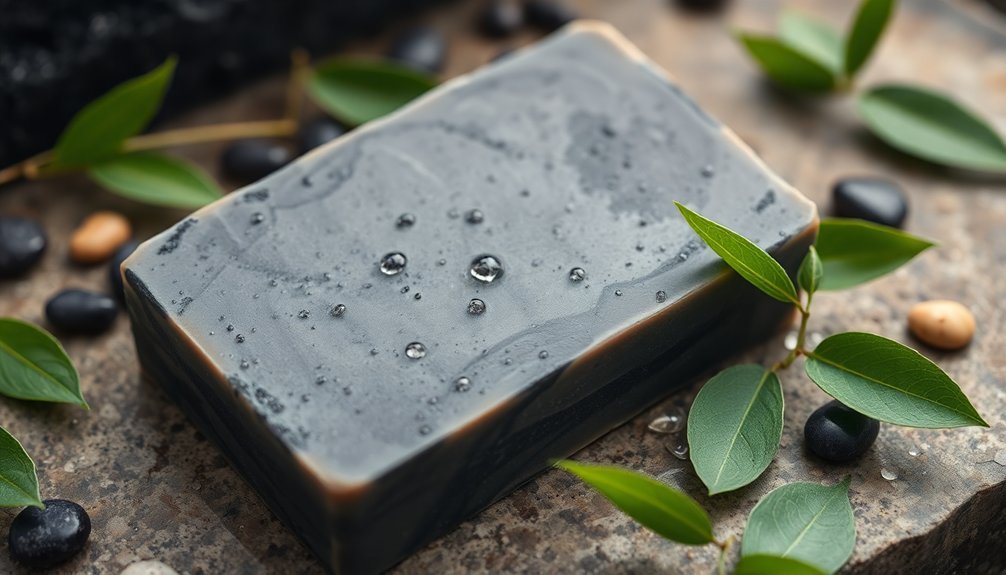The three best volcanic ash soap methods for exfoliation are layered volcanic ash bars with distinct exfoliating zones, hot process fusion that blends essential oils with volcanic minerals, and cold-pressed formulations that preserve detoxifying properties. You'll benefit from volcanic ash's natural antibacterial qualities and gentle exfoliation that removes dead skin cells without causing micro-tears. Each method offers unique advantages for different skin types and desired therapeutic effects, from acne treatment to overall skin rejuvenation.
Creating a Layered Volcanic Ash Exfoliating Bar

While many commercial exfoliants contain harsh microbeads, volcanic ash offers a natural alternative with remarkable benefits for your skin. Its anti-bacterial properties help combat acne while gently removing dead skin cells without causing micro-tears.
To create your own layered bar, you'll need volcanic ash or pumice powder, sodium palmate, sodium olivate, kaolin clay, and Vitamin E. You can also incorporate Icelandic black sand as an effective natural exfoliant that pairs well with volcanic elements.
The melt and pour method works best for achieving distinct layers with varying textures. Control temperature carefully to prevent premature setting as you add each layer.
For best results, differentiate layers with mica coloring and select appropriate molds for an appealing presentation.
The finished bar should be stored in a cool, dry place and used 1-2 times weekly, followed by moisturizer.
Hot Process Fusion: Blending Volcanic Ash With Essential Oils
Unlike the layered volcanic ash bars, hot process fusion reveals deeper therapeutic benefits by thoroughly integrating essential oils with volcanic minerals.
Volcanic hot process soaping unlocks minerals' full therapeutic potential through complete essential oil integration.
You'll maximize exfoliation while preserving essential oil properties using crockpot or double boiler methods.
When crafting your volcanic ash soap using hot process techniques, follow these key steps:
- Heat your soap base to 140°F using your preferred method (crockpot works exceptionally well for even heat distribution).
- Add volcanic ash (3-5% of total weight) when the soap reaches trace stage.
- Allow mixture to cook until it reaches mashed potato consistency.
- Cool to 120°F before adding essential oils to preserve their therapeutic properties.
This fusion approach guarantees the mineral-rich ash distributes evenly while maintaining the fragrance stability that hot process soaps are known for. Remember to always wear protective gear when working with lye to ensure safety during the soap-making process.
Cold-Pressed Volcanic Ash Soap With Natural Moisturizers

Cold-pressed volcanic ash soap represents the gentlest approach to harnessing volcanic minerals without compromising their natural benefits. This method preserves the detoxifying and exfoliating properties of volcanic ash while incorporating moisturizing ingredients that nourish your skin.
The process involves small-batch crafting with organic olive and coconut oils, enriched with shea and cocoa butters. These natural moisturizers work alongside volcanic ash to create a perfect balance—drawing out impurities while preventing dryness. The inclusion of sustainable palm oil helps create a firmer bar that lasts longer with proper care.
For enhanced hydration, ingredients like coconut milk and sweet almond oil are often added. You'll find this soap particularly effective if you have sensitive, acne-prone, or dry skin.
The several-month curing time guarantees each bar develops ideal hardness and effectiveness, delivering gentle exfoliation without harsh synthetic additives.
Frequently Asked Questions
Can Volcanic Ash Soap Irritate Sensitive Skin Conditions?
Yes, volcanic ash soap can irritate sensitive skin conditions. It's drying and may cause redness if you have eczema or sensitivity. You'll want to patch test first and moisturize after use.
How Often Should Volcanic Ash Soap Be Used for Optimal Results?
For best results, you should use volcanic ash soap 1-2 times weekly for normal skin. If you've got sensitive skin, limit usage to every 10-14 days. Always moisturize afterward and don't forget sunscreen.
Is Volcanic Ash Soap Safe During Pregnancy?
You should avoid unprocessed volcanic ash soap during pregnancy due to irritation risks. If you're using commercially processed products, consult your healthcare provider first and always patch test for safety.
Can Volcanic Ash Soap Cause Skin Dryness With Prolonged Use?
Yes, volcanic ash soap can cause skin dryness with prolonged use due to its oil-absorbing properties. You'll want to limit usage to 1-3 times weekly and always follow with a good moisturizer.
Does Volcanic Ash Soap Expire or Lose Effectiveness Over Time?
Yes, your volcanic ash soap expires after 1-2 years. It'll lose exfoliating properties, fragrance, and effectiveness over time. Store it in cool, dry places away from sunlight to maximize its shelf life.
In Summary
Volcanic ash soap transforms your skincare routine with powerful exfoliation that's natural and effective. Whether you've chosen the layered bar, hot process fusion, or cold-pressed method, you're now equipped to harness earth's minerals for smoother, healthier skin. Don't hesitate to experiment with different essential oils and moisturizers to customize your creation. You'll love how these homemade soaps leave your skin feeling refreshed and renewed.





Leave a Reply